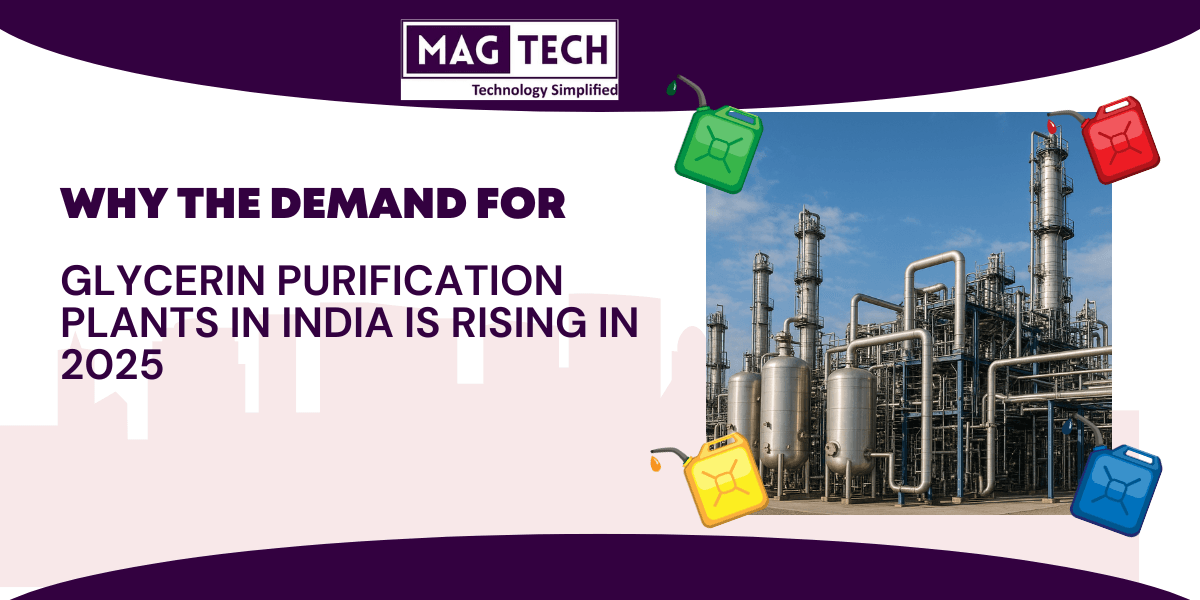Before starting the topic of glycerin market analysis -glycerin, a versatile by-product of biodiesel production, is gaining increasing attention in global markets. This colorless, odorless liquid is essential in various industries—from personal care to pharmaceuticals. It is experiencing dynamic supply, demand, and pricing shifts, largely influenced by the growing biodiesel sector.
This growing supply is reshaping traditional pricing models and driving innovation in glycerin applications. The intersection of biodiesel and glycerin markets highlights a complex interplay between environmental goals and economic factors.
Understanding these trends is crucial for stakeholders across industries as they scout the evolving global market of glycerin. Here, we will do a comprehensive glycerin market analysis to understand the trends driving its growth.
Before we dig deeper, let us understand how glycerin is produced during biodiesel production.
Table of Contents
ToggleGlycerin: A By-product of Biodiesel Production
Glycerin is produced as a by-product of biodiesel manufacturing through transesterification. During this process, cooking oil (UCO), animal fats, and restaurant grease react with methanol to create biodiesel and glycerin. The reaction separates glycerin from the biodiesel, leaving it as a thick, sticky liquid. It is then refined to remove impurities and can be used in various applications.
We now understand how glycerin is linked to biodiesel production. Here is the global market overview to understand its supply and pricing dynamics.
Glycerin Market Analysis: Factors Supporting its Impressive Growth
The glycerin market has evolved significantly since 2004. This year marked the “first biodiesel revolution,” which made the biodiesel industry the leading source of glycerin. Before 2004, glycerin was mainly produced through hydrolysis for soap and fatty acid production. Today, about 66% of global glycerin production comes from biodiesel, a significant shift from past methods.
Impact of Biodiesel on Glycerin Supply
The production of glycerin skyrocketed with the rise of biodiesel. The “second biodiesel revolution” in 2010, which focused on waste-based biodiesel, impacted both the quantity and quality of crude glycerin. While the production volume grew, the glycerin from waste-based biodiesel had a lower purity, with glycerol content ranging between 40% and 75%.
This rapid expansion of biodiesel led to an oversupply of glycerin in the market. The production more than doubled over the last decade, creating a supply glut as the market struggled to absorb the increased output. This imbalance between glycerin supply and market demand forced producers to explore new applications for the by-product. It eventually led to a rise in the number of industries using glycerin.
Current Supply and Demand Trends
As demand caught up, glycerin found applications in various industries, including pharmaceuticals, personal care, and food. These sectors, particularly in developing regions like Southeast Asia, are driving the current demand for glycerin. The glycerin market analysis suggests that it has now reached a turning point where demand is outpacing supply.
The refined glycerin market is growing rapidly, especially in Southeast Asia, where rising living standards in countries like China and India have fueled demand for personal care and pharmaceutical products. For example, in 2014, China imported 795,000 metric tons of crude glycerin and 164,000 metric tons of refined glycerin, marking a 30% increase in import volumes compared to the previous year.
By 2015, China’s total refined glycerin consumption reached 918,000 metric tons, with future growth expected as personal care products become more widely available to the growing middle class.
In Europe, the largest consumer of crude glycerin, the market for refined glycerin is also robust. Europe consumes 28% of the world’s refined glycerin, driven by demand in various industries like cosmetics, food, and pharmaceuticals. North America follows with around 19% of the global refined glycerin consumption.
Market Volatility and Pricing
The glycerin market is known for its volatility. Since glycerin is a by-product of biodiesel production, its supply does not necessarily respond to market demand for glycerin but to biodiesel. This disconnection often leads to supply fluctuations, especially when biodiesel production rises or falls. Historically, glycerin prices were low due to oversupply. However, as more industries adopted glycerin and biodiesel production expanded, prices began to stabilize and, in some cases, increase.
Today, the demand from developed countries, coupled with the growing needs of developing regions like Southeast Asia, is pushing glycerin prices higher. It remains difficult to predict future pricing trends, as they will depend largely on the biodiesel market, particularly in Europe and Asia.
Future Growth Prospects
The global glycerin market continues to grow in response to increasing demand and the discovery of new applications. The production of biodiesel, especially in Asia and Argentina, is expected to help balance the market, ensuring a steady supply.
However, the market is also subject to potential disruptions from the introduction of Hydrotreated Vegetable Oil (HVO) production, which does not yield glycerin as a by-product. Still, HVO’s impact on glycerin production will remain limited for now.
Current Market Valuation and Forecast Period (2024 – 2032)
The global glycerin market analysis shows it is growing at a CAGR of more than 5.2% from 2024 to 2032. It crossed US$ 3.79 Billion in 2023, US$ 2.95 Billion in 2024, and is expected to reach US$ 4.42 Billion by 2032.
The current market valuation highlights a strong recovery and expansion from the earlier period’s slower growth. This resurgence is driven by several factors.
1. Increased biodiesel production: The rise in biodiesel production continues to influence the glycerin market. As biodiesel production ramps up, the availability of glycerin increases, making it more accessible and affordable for various industries.
2. Growing personal care industry: The personal care sector remains a significant driver of glycerin demand. The increasing preference for natural and organic beauty products has heightened the need for glycerin, known for its moisturizing and skin-softening properties.
3. Pharmaceutical sector expansion: The pharmaceutical industry continues to rely on glycerin for its role in drug formulation and as a sweetening agent. The ongoing development of new medications and formulations contributes to the market’s growth.
4. Rising food and beverage applications: Glycerin’s use in the food and beverage industry as a humectant and sweetener drives demand. The trend towards processed and convenience foods supports this growth.
5. Technological advancements: Innovations in glycerin production and refining technologies have enhanced the quality and application scope of glycerin. This advancement helps meet the evolving demands of various industries.
Despite these positive trends, the market faces challenges such as fluctuating raw material prices and regulatory changes. However, the overall outlook for the glycerin market potential remains optimistic. Let us proceed to understand the supply dynamics of this market.
Glycerin Supply Analysis: An Overview
Key Raw Materials and Production Processes
Glycerin is primarily produced as a byproduct in the biodiesel manufacturing process. In biodiesel production, oils or fats are converted into fatty acid methyl esters (FAME a.k.a. biodiesel) and glycerin. The glycerin is then refined to meet industry standards, such as USP grade for pharmaceuticals or technical grade for industrial applications.
Geographic Distribution of Supply
The global glycerin supply is geographically diverse, with major production hubs in Asia Pacific, North America, and Europe. Asia Pacific, particularly countries like China and India, is a significant source due to its growing biodiesel industry and chemical manufacturing.
North America, with its well-established chemical industry, also contributes notably to glycerin production. Europe, driven by stringent regulatory standards and a strong demand for high-purity glycerin, is another key player.
Recent Changes or Disruptions in the Supply Chain
In recent years, several disruptions have occurred in the glycerin supply chain. The COVID-19 pandemic had a notable impact, causing shortages due to lockdowns and disruptions in manufacturing and logistics.
Production slowdowns and supply chain interruptions affected the availability of raw materials and finished products. Geopolitical factors, such as trade tensions and regulatory changes, have also influenced the supply chain.
For instance, fluctuations in trade policies and tariffs can impact raw material costs and availability, affecting glycerin production. Despite these challenges, the market has shown resilience, with efforts to stabilize supply and adapt to changing conditions.
Glycerin Demand Analysis: Scouting Various Industries
Key Industries and Applications Driving Demand
Glycerin finds wide use across several industries, driving its demand globally. In the personal care sector, it is a staple ingredient in products like soaps, lotions, and shampoos due to its moisturizing properties.
In the pharmaceutical industry, glycerin is used in cough syrups, expectorants, and as a base for various oral medications. The food and beverages industry also relies on glycerin as a sweetener, preservative, and humectant in products such as baked goods and confectioneries. Additionally, glycerin’s use in industrial applications, such as in the production of explosives and antifreeze, contributes to its high demand.
Regional Demand Variations
Demand for glycerin varies by region, influenced by local industry needs and economic conditions.
In North America and Europe, the demand for high-purity glycerin is strong due to stringent regulations and high standards in pharmaceuticals and personal care products. These regions also have established infrastructure for biodiesel production, which supports glycerin supply.
In Asia Pacific, the growing personal care and food industries drive substantial glycerin demand. Emerging economies in this region are increasing their consumption of glycerin as industrial applications expand.
Meanwhile, in Latin America and the Middle East, glycerin demand is growing as these regions develop their industrial sectors and increase biodiesel production.
Trends Influencing Demand
Several trends are shaping glycerin demand. Here is a list of the trends that is driving its demand.
1. Natural & Organic Products: Increasing consumer preference for natural ingredients drives demand in the personal care and food sectors.
2. Technological Advancements: Improved biodiesel production technologies enhance glycerin yield and quality.
3. Sustainability Push: Growing focus on green energy and sustainable practices boosts glycerin production. This boost is simultaneously supporting the requirement of glycerin in other industries.
The demand and supply signify the glycerin market potential and control the pricing trends. Let us look into its pricing trends in a detailed manner.
Glycerin Pricing Trends and Analysis: Q1 vs. Q2 2024
The demand for glycerin governs the pricing trends to a considerable extent. If we consider the two latest quarters of 2024, we can derive the pricing trends and factors influencing them.
North America
Q1 2024:
- Prices: The Crude glycerin 80% FOB Houston ended at USD 285/MT, reflecting a slight decline of 0.31% from the previous quarter.
- Factors Influencing Prices:
- Surplus Production: High production levels led to a surplus.
- Demand Fluctuations: Reduced demand from downstream industries.
- Raw Material Costs: Falling palm oil prices contributed to lower glycerin prices.
- Supply Chain Disruptions: Increased shipping costs and logistical issues.
Q2 2024:
- Prices: The Crude glycerin 80% FOB Houston fell to USD 265/MT, marking an 11% decrease from the same quarter last year and a 6% drop from Q1 2024.
- Key Drivers:
- Oversupply: Excess production flooded the market.
- Weak Demand: Anticipated stockpiling did not boost demand.
- Higher Costs: Increased energy prices pressured producers to cut expenses.
Analysis: The downward trend in Q2 was more pronounced than in Q1. The oversupply and weak demand significantly impacted prices, exacerbated by rising energy costs.
Asia Pacific (APAC)
Q1 2024:
- Prices: glycerin Refined USP 99.5% CFR Busan in South Korea stood at USD 760/MT, reflecting a downward trend.
- Factors Influencing Prices:
- Restricted Inventories: Low-end manufacturing units faced tight inventories.
- Seasonal Demand: Increased international demand impacted prices.
- Edible Oil Prices: Variations in palm oil prices affected glycerin costs.
Q2 2024:
- Prices: The price in South Korea dropped to USD 720/MT, a 4% decrease from the previous quarter.
- Key Drivers:
- Inventory Glut: An overabundance of stock from prior bulk acquisitions.
- Inflation: Reduced consumer confidence and purchasing activities.
- Rising Costs: Increased production expenses put downward pressure on prices.
Analysis: The APAC region saw a consistent decline, with South Korea experiencing significant adjustments. The inventory surplus and inflationary pressures were primary contributors to the price drop.
Europe
Q1 2024:
- Prices: The Crude glycerin 80% FOB Hamburg in Germany was USD 355/MT, with a mild decrease.
- Factors Influencing Prices:
- Oversupply: High inventory levels from previous months.
- Demand Weakness: Reduced purchasing activity and inflationary pressures.
- Competitive Pricing: Lower production costs led to more competitive offers.
Q2 2024:
- Prices: The price fell to USD 335/MT, reflecting a 5% decrease compared to both the same quarter last year and Q1 2024.
- Key Drivers:
- Continued Oversupply: Excess stock remained a significant issue.
- Subdued Demand: Weakened consumer trust and reduced buying activities.
- Competitive Market: Persistent competitive pricing due to lower production costs.
Analysis: Europe’s glycerin market faced a steady decline in Q2. Oversupply and weakened demand continued to drive prices down, with competitive pricing from lower production costs further impacting the market.
Middle East and Africa (MEA)
Q1 2024:
- Prices: glycerin Refined USP 99.5% CFR Izmir in Turkey was USD 2000/MT, showing stability.
- Factors Influencing Prices:
- Balanced Supply-Demand: A relatively stable market with balanced inventory levels.
- Geopolitical Conditions: Stable geopolitical conditions influenced transportation costs.
Q2 2024:
- Prices: Prices dropped to USD 1660/MT, a 21% decrease year-over-year and a 9% decline from Q1 2024.
- Key Drivers:
- Excess Inventory: A significant surplus from previous bulk acquisitions.
- Weakened Demand: Reduced purchasing activities amidst inflation.
- Cost Reductions: Lower input costs in the palm oil sector and reduced freight charges.
Analysis: The MEA region experienced the most significant price drop in Q2. Persistent oversupply and reduced demand, combined with decreasing input costs, led to a notable decline in prices.
Across all regions, Q2 2024 saw a more pronounced decline in glycerin prices compared to Q1. Key factors include oversupply, reduced demand, and rising production costs. Each region faced unique challenges, but the overall trend indicates a challenging period for the glycerin market globally.
Glycerin: A Potent Revenue Generator for Biodiesel Manufacturers
This detailed glycerin market analysis clearly explains how the global scenario is going to change. It explains how local and global biodiesel producers can create a potential channel for revenue generation by supplying this by-product to various industries.
With emerging applications and increasing demand, glycerin provides a profitable by-product for biodiesel producers. Though volatile, the market’s potential is clear, offering steady growth and new opportunities for those who capitalize on this versatile substance. The future of glycerin lies in its diverse uses and expanding global market.
To know more about biodiesel production and glycerin manufacturing, contact MAGTECH today. We offer diverse expertise to plan and set up biodiesel manufacturing units. With our experts, you can tap the potential of the growing glycerin market indigenously and globally.


